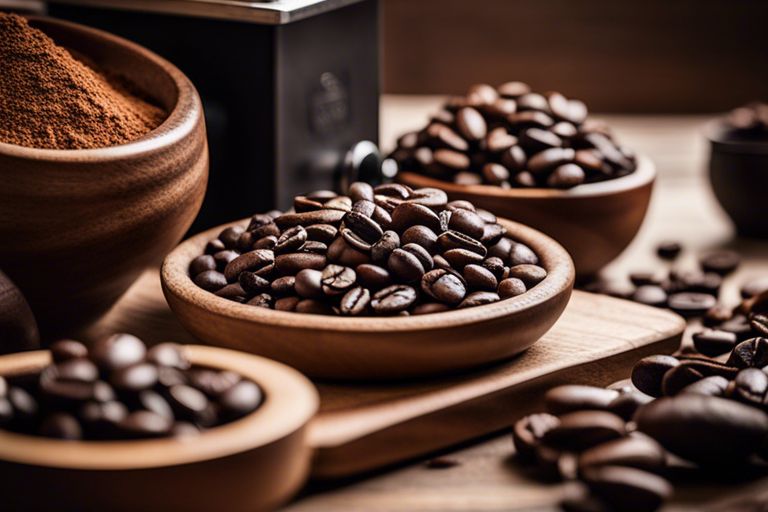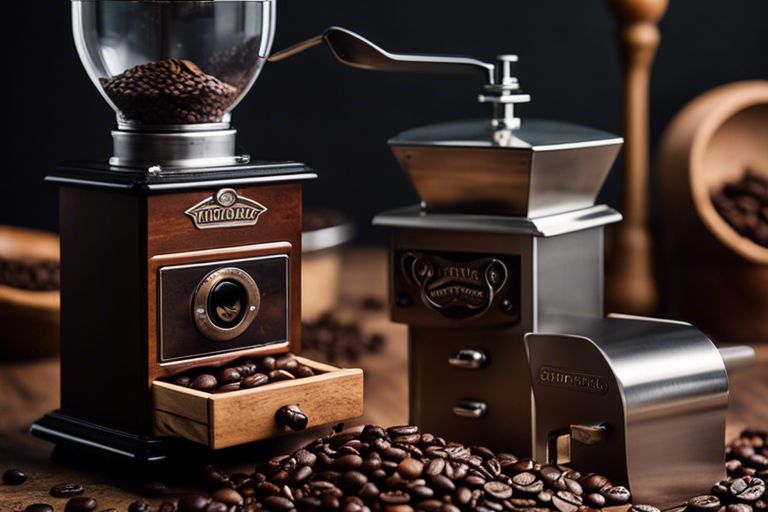Most coffee enthusiasts have heard of the Chemex, but not everyone knows how to use this elegant brewing device to make a perfect cup of coffee. The Chemex is a pour-over coffee maker that produces a clean and flavorful brew. In this blog post, we will explore what exactly a Chemex is, how it works, and the step-by-step process of using it to make delicious coffee at home.

Key Takeaways:
- Chemex is a type of pour-over coffee maker: Chemex is a pour-over coffee maker known for its elegant design and ability to produce clean and crisp coffee.
- It uses a special Chemex Bonded Coffee Filter: The Chemex works by placing a special Chemex Bonded Coffee Filter in the top chamber to hold the coffee grounds while allowing the brewed coffee to pass through.
- Steps to use a Chemex: To use a Chemex, grind coffee beans to a medium-coarse consistency, place the filter in the Chemex, add the coffee grounds, pour hot water over the grounds in circular motions, and enjoy a delicious cup of coffee.
History of Chemex
Invention and Patent
History of the Chemex dates back to 1941 when German inventor Dr. Peter Schlumbohm created this iconic brewing device. Schlumbohm, a chemist with a passion for creating simple but elegant solutions, designed the Chemex with both form and function in mind. In 1942, he was granted a patent for his innovative pour-over coffee maker, which featured a hourglass shape made from borosilicate glass and a wooden collar tied with a leather cord.
Evolution of Design
Patent documents reveal that Schlumbohm’s original design of the Chemex included a heat-resistant glass handle. However, over the years, the handle was eliminated from the design in favor of the sleek, hourglass shape with a wooden collar that we recognize today. This evolution of the design not only added to the aesthetic appeal of the Chemex but also made it more functional and elegant in its simplicity.
Chemex’s design has stood the test of time, maintaining its iconic status as a classic coffee brewing device that combines artistry with functionality. The Chemex remains a favorite among coffee enthusiasts for its ability to produce a clean, flavorful cup of coffee through its unique brewing process.

What is a Chemex
One Your Chemex Has Some Tricks up Its Sleeve.
Definition and Description
Chemex is a pour-over coffee maker that has become a staple in many coffee lovers’ kitchens. Its elegant hourglass shape and wooden collar make it not only a functional brewing device but also a beautiful piece of design.
Materials and Construction
Chemex is typically made of high-quality, heat-resistant glass that does not absorb any flavors or odors, ensuring that your coffee tastes just the way it should. The wooden collar and leather tie not only add to its aesthetic appeal but also provide a comfortable grip while pouring.
Construction: The unique construction of the Chemex allows for a slow and controlled brewing process, where hot water is poured over coffee grounds in a specially designed filter. The resulting coffee is smooth, clean, and flavorful, showcasing the true essence of the beans used.
How to Use a Chemex
Many coffee enthusiasts love using a Chemex for its ability to brew a clean and flavorful cup of coffee. Using a Chemex may seem intimidating at first, but with a little practice, you can perfect the art of brewing coffee with this elegant brewer.
Step-by-Step Brewing Guide
| Step | Instructions |
| 1 | Grind fresh coffee beans to a medium-coarse consistency. |
| 2 | Place a Chemex paper filter in the brewer and rinse it with hot water. |
| 3 | Add the ground coffee to the filter and pour hot water over it in a circular motion. |
| 4 | Allow the coffee to steep for a few minutes, then remove the filter and serve. |
Tips for Optimal Flavor
An vital tip for brewing with a Chemex is to use high-quality, freshly roasted coffee beans for the best flavor. It’s also crucial to pre-wet the coffee grounds before brewing to ensure they are evenly saturated and to release trapped gases for better extraction.
- Experiment with different coffee-to-water ratios and brewing times to find your perfect cup.
On top of that, using a gooseneck kettle can give you more control over the water flow, which is vital for a consistent and balanced extraction. After mastering the basics, don’t be afraid to get creative with different brewing techniques to enhance the flavors of your coffee.
This classic brewing method may take a few tries to get the hang of, but the results are well worth the effort. Experimenting with grind size, water temperature, and pouring technique can help you unlock a world of flavors in your daily cup of coffee.
Benefits of Using a Chemex
Once again, if you’re wondering why Chemex coffee makers are highly praised in the coffee enthusiast community, a visit to Why are Chemex so praised? : r/Coffee might give you a glimpse. These elegant yet simple brewers offer several advantages that make them stand out in the world of coffee brewing.
Clean and Balanced Flavor
The Chemex is known for producing a clean and balanced flavor profile that highlights the nuances of the coffee beans without any bitterness or sediment. The thick filter paper removes oils and any fine particles, resulting in a crisp and smooth cup of coffee that is highly enjoyable for many enthusiasts.
Easy to Clean and Maintain
Cleanliness and maintenance are crucial in coffee brewing, and the Chemex excels in this aspect. The glass body is easy to clean with soap and water, and the wooden collar and leather tie can be removed for washing. Additionally, the Chemex filters are disposable, making cleanup a breeze after brewing a delicious pot of coffee.
Maintain
The Chemex is not only easy to clean but also simple to maintain. With proper care, such as regular cleaning and replacing worn-out parts, a Chemex can last for years, making it a durable and sustainable brewing option for coffee lovers.
Versatility in Brewing Methods
For coffee aficionados who appreciate variety in their brewing methods, the Chemex offers versatility. Whether you prefer hot pour-over coffee, iced coffee, or even experimenting with cold brew techniques, the Chemex can adapt to different styles of coffee preparation, giving you the freedom to explore and enjoy various brewing methods.
Methods
Its unique design and functionality allow users to control brewing variables such as water temperature, grind size, and pour rate, making it a versatile brewing tool for those who want to tailor their coffee-making process to suit their preferences.

Comparison to Other Brewing Methods
For Brew Guide: Chemex | How to Use the …, let’s compare the Chemex to other popular brewing methods to understand its uniqueness and advantages.
Drip Brewing
The Drip Brewing method, popular in devices like the traditional coffee maker, drips hot water over coffee grounds held in a filter. This process extracts the coffee slowly, resulting in a smooth and consistent flavor. The Chemex takes a similar approach but offers a more hands-on experience and the ability to control variables like water temperature and pouring technique to achieve a customized brew.
French Press
French Press brewing involves steeping coffee grounds in hot water and then pressing them down with a plunger. This method produces a rich and full-bodied coffee with a robust flavor profile. While the French Press offers a bold cup, the Chemex delivers a cleaner and more nuanced taste by using a paper filter to remove oils and sediment, resulting in a lighter mouthfeel.
A French Press creates a full-bodied coffee with a thick texture due to fine particles escaping through the mesh filter. This can sometimes leave a slight bitterness in the brew, unlike the cleaner profile achieved with a Chemex.
Pour-over
Methods such as the Hario V60 and Kalita Wave fall under the Pour-over category, where hot water is poured over coffee grounds in a filter. The main difference between the Chemex and these pour-over devices lies in the Chemex’s thicker filter and unique hourglass shape, allowing for a slower brew time and enhanced extraction of flavors.
The Chemex’s design, including the bonded filters and thick paper material, gives the brewer greater control over the extraction process, resulting in a well-balanced and flavorful cup of coffee.
Other
Common Misconceptions about Chemex
Is it Difficult to Use?
Not at all. One common misconception about the Chemex is that it is difficult to use. In reality, it is quite simple and straightforward. All you need to do is place a filter in the Chemex, add your ground coffee, pour hot water over it in a slow and steady manner, and let it drip through. The whole process is not only user-friendly but also allows you to have full control over the brewing variables to create a delicious cup of coffee.
Is it Only for Coffee Snobs?
Only those who have not tried using a Chemex would claim that it is only for coffee snobs. The truth is that anyone can use a Chemex to brew their coffee, regardless of their level of expertise or snobbery. The simplicity of the Chemex design and the quality of coffee it produces make it a versatile brewing method suitable for coffee enthusiasts of all kinds.
To think that the Chemex is only for coffee snobs is to underestimate its accessibility and versatility. Whether you are a coffee aficionado or just someone who enjoys a good cup of joe, the Chemex can cater to your brewing needs without any pretentiousness.
Final Words
The Chemex is a simple yet effective brewing device that produces a clean and flavorful cup of coffee. Its elegant design and use of paper filters result in a smooth and rich coffee without any sediment. By following the proper brewing method, one can easily create a great cup of coffee using a Chemex.
The Chemex’s unique hourglass shape, wooden collar, and leather tie make it a stylish addition to any coffee lover’s collection. Its ease of use and ability to brew multiple cups at once make it a versatile and convenient brewing device. So next time you’re looking to elevate your coffee brewing experience, give the Chemex a try and enjoy a delicious cup of coffee.
FAQ
Q: What is a Chemex?
A: A Chemex is a glass coffee maker that is known for its elegant design and ability to produce a clean and flavorful cup of coffee.
Q: How is a Chemex different from other coffee makers?
A: Unlike other coffee makers, a Chemex uses a paper filter that is thicker than most, which results in a smooth and sediment-free coffee.
Q: What are the key components of a Chemex?
A: The key components of a Chemex include the glass carafe, the Chemex bonded filters, and the wooden collar and tie, which serve as a handle.
Q: How is a Chemex used to make coffee?
A: To use a Chemex, you first place a Chemex bonded filter in the top of the carafe, add your coffee grounds, pour hot water over the grounds in a circular motion, and let it drip through the filter.
Q: What are some tips for using a Chemex?
A: Some tips for using a Chemex include rinsing the filter before adding the coffee grounds, using a gooseneck kettle for better control over pouring, and experimenting with the coffee-to-water ratio to find your preferred strength.
What are the best coffee regions in the world








